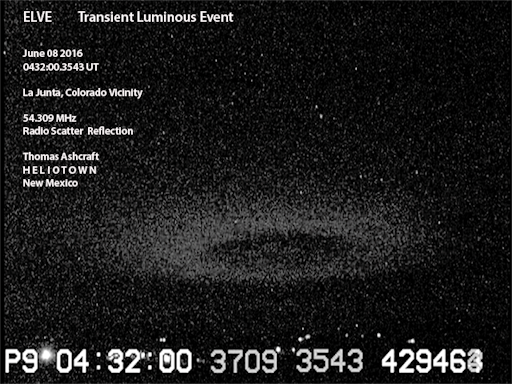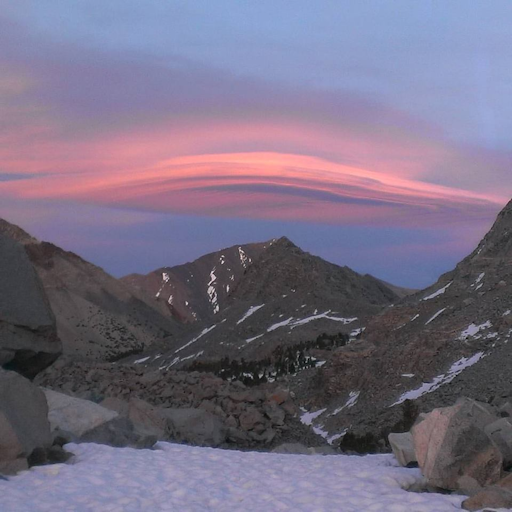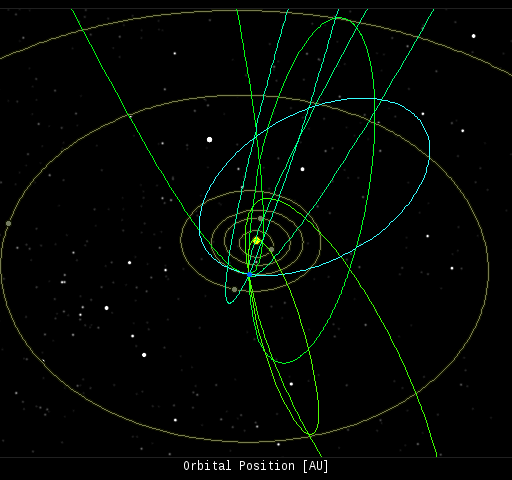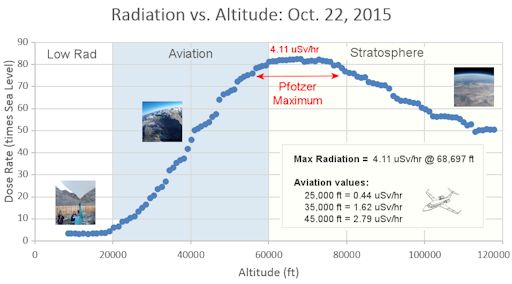It's waiting for you: The most successful Aurora Photo Tour on Earth! 100% success rate 4 years in a row and winner of the TripAdvisor Certificate of Excellence Award. Join LapplandMedia's aurora tours in Abisko, Swedish Lapland! | | | QUIET SUN: Solar activity remains very low. Both sunspots on the Earthside of the sun have stable magnetic magneticfields that pose little threat for explosions. NOAAforecasters say there is no more than a 1% chance of strong flares on June 12th. Solar flare alerts: text or voice DOUGHNUT OF LIGHT OVER COLORADO: On June 8th, high above a thunderstorm in Colorado, an enormous ring of light appeared near the edge of space. Amateur astronomer Thomas Ashcraft photographed the phenomenon using a low-light video camera. 
"It only lasted about a millisecond," says Ashcraft, "but it was definitely there. The ring was about 300 km wide," he estimates. This is an example of an ELVE (Emissions of Light and Very Low Frequency Perturbations due to Electromagnetic Pulse Sources). First seen by cameras on the space shuttle in 1990, ELVEs appear when a pulse of electromagnetic radiation from lightning propagates up toward space and hits the base of Earth's ionosphere. A faint ring of light marks the broad 'spot' where the EMP hits. ELVES often appear alongside red sprites. Indeed, Ashcraft's camera caught a cluster of sprites leaping straight up through the middle of the donut. "Play the complete video to see the sprites," says Ashcraft. ELVEs are elusive--and that's an understatement. Blinking in and out of existance in only 1/1000th of a second, they are completely invisible to the human eye. For comparison, red sprites tend to last for hundredths of a second and regular lightning can scintillate for a second or more. Their brevity explains why ELVEs are a more recent discovery than other lightning-related phenomenon. Learn more about the history and physics of ELVEs here and here. Realtime Sprite Photo Gallery UFO-SHAPED CLOUDS: On the evening of June 9th, a spectacular array of UFO-shaped clouds appeared above California's Eastern Sierra mountain range. The display was a sensation on social media as people in nearby valleys began posting pictures of the sunset-colored armada. One photographer, unlike the others, was in the mountains; ultrarunner Jeff Kozak of Bishop CA captured this edge-on view from 11,100 feet: 
"I was topping out on Morgan Pass at sunset when I looked south to see what I thought was The Mothership hovering over Mt Tom!" says Kozak. In fact, it was a lenticular cloud. Lenticular clouds form downwind of mountain ranges where the air organizes itself into starship-sized waves. Although they appear stationary, moist air is constantly moving through them, condensing at the apex of the wave. Wind sculpts the clouds into giant saucers and voilà--spaceships in the sky. For more information about lenticular clouds, click here. Realtime Space Weather Photo Gallery SPACE BALLS FOR FATHER'S DAY (JUNE 19th): What do you give the Father who has everything? Space Balls! A few days ago, the students of Earth to Sky Calculus flew a basket of space-helmeted golf balls to the edge of space, 36.3 km (119,000 feet) above Earth's surface on board a high altitude helium balloon: 
After the balloon exploded, the balls parachuted back to Earth, landing in the volcanic tablelands north of Bishop CA. For $49.95 you can have one of these balls (space helmet included) along with a unique Father's Day card showing the balls floating at the top of Earth's atmosphere. The interior of the card tells the story of the flight and confirms that this gift has been to the edge of space and back again. All sales support student space weather research. In fact, the balls pictured above were hitchhiking on a payload equipped with radiation sensors. We send the sensors to the stratosphere every week to monitor increasing levels of cosmic rays. Visit the Earth to Sky store to support this crowd-funded research. Realtime Aurora Photo Gallery
Realtime Noctilucent Cloud Photo Gallery
Realtime Comet Photo Gallery Every night, a network of NASA all-sky cameras scans the skies above the United States for meteoritic fireballs. Automated software maintained by NASA's Meteoroid Environment Office calculates their orbits, velocity, penetration depth in Earth's atmosphere and many other characteristics. Daily results are presented here on Spaceweather.com. On Jun. 10, 2016, the network reported 24 fireballs.
(22 sporadics, 1 Daytime Arietid, 1 June mu Cassiopeiid)  In this diagram of the inner solar system, all of the fireball orbits intersect at a single point--Earth. The orbits are color-coded by velocity, from slow (red) to fast (blue). [Larger image] [movies] Potentially Hazardous Asteroids ( PHAs) are space rocks larger than approximately 100m that can come closer to Earth than 0.05 AU. None of the known PHAs is on a collision course with our planet, although astronomers are finding new ones all the time. On June 12, 2016 there were 1704 potentially hazardous asteroids. Notes: LD means "Lunar Distance." 1 LD = 384,401 km, the distance between Earth and the Moon. 1 LD also equals 0.00256 AU. MAG is the visual magnitude of the asteroid on the date of closest approach. | | Cosmic Rays in the Atmosphere | | Situation Report -- Oct. 30, 2015 | Stratospheric Radiation (+37o N) | | Cosmic ray levels are elevated (+6.1% above the Space Age median). The trend is flat. Cosmic ray levels have increased +0% in the past month. | | Sept. 06: 4.14 uSv/hr (414 uRad/hr) | | Sept. 12: 4.09 uSv/hr (409 uRad/hr) | | Sept. 23: 4.12 uSv/hr (412 uRad/hr) | | Sept. 25: 4.16 uSv/hr (416 uRad/hr) | | Sept. 27: 4.13 uSv/hr (413 uRad/hr) | | Oct. 11: 4.02 uSv/hr (402 uRad/hr) | | Oct. 22: 4.11 uSv/hr (411 uRad/hr) | These measurements are based on regular space weather balloon flights: learn more. Approximately once a week, Spaceweather.com and the students of Earth to Sky Calculus fly "space weather balloons" to the stratosphere over California. These balloons are equipped with radiation sensors that detect cosmic rays, a surprisingly "down to Earth" form of space weather. Cosmic rays can seed clouds, trigger lightning, and penetrate commercial airplanes. Our measurements show that someone flying back and forth across the continental USA, just once, can absorb as much ionizing radiation as 2 to 5 dental X-rays. For example, here is the data from a flight on Oct. 22, 2015: 
Radiation levels peak at the entrance to the stratosphere in a broad region called the "Pfotzer Maximum." This peak is named after physicist George Pfotzer who discovered it using balloons and Geiger tubes in the 1930s. Radiation levels there are more than 80x sea level. Note that the bottom of the Pfotzer Maximim is near 55,000 ft. This means that some high-flying aircraft are not far from the zone of maximum radiation. Indeed, according to the Oct 22th measurements, a plane flying at 45,000 feet is exposed to 2.79 uSv/hr. At that rate, a passenger would absorb about one dental X-ray's worth of radiation in about 5 hours. The radiation sensors onboard our helium balloons detect X-rays and gamma-rays in the energy range 10 keV to 20 MeV. These energies span the range of medical X-ray machines and airport security scanners. | | The official U.S. government space weather bureau | | | The first place to look for information about sundogs, pillars, rainbows and related phenomena. | | | Researchers call it a "Hubble for the sun." SDO is the most advanced solar observatory ever. | | | 3D views of the sun from NASA's Solar and Terrestrial Relations Observatory | | | Realtime and archival images of the Sun from SOHO. | | | from the NOAA Space Environment Center | | | the underlying science of space weather |  | Tobi -- Proud Supporter of Space Education! |  | Claim your tax refund with this UK tax rebate company and get back your overpaid tax. |  | Enjoy this fabulous range of leather sofas from a leader in the UK sofa manufacturer industry.. | | 
